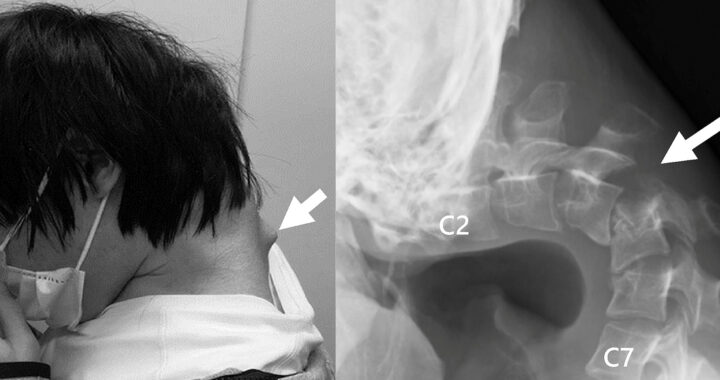A team of Japanese medical professionals documented a striking case of a 25-year-old man who developed an extreme form of neck weakness that rendered him unable to lift his own head. This severe condition, known as dropped head syndrome or severe cervical kyphosis, was attributed to his habit of looking down at his smartphone for extended periods while gaming. Others called the condition smartphone slouch and tech-neck syndrome.
Severe Cervical Kyphosis in a Young Patient: A Case Study of Dropped Head Syndrome
Background
Cervical kyphosis, also known as dropped head syndrome, is a medical condition involving severe weakness of the neck muscles. It is more common among elderly patients with other conditions like degenerative spondylosis, other neurological diseases, or neuromuscular disorders. However, it is rarely seen in young adults, especially with complications.
The report from Japanese medical professionals detailed a case of a 25-year-old man who sought medical intervention due to severe neck pain that lasted for more than six months, an inability to lift his head that resulted in a permanently slumped position, a horizontal gaze disorder, and dysphagia or difficulty in swallowing, which led to significant weight loss.
Extended details of the case, specific diagnosis, and the corresponding medical interventions were discussed and documented in 2023 in the JOS Case Reports of the Japanese Orthopedic Association. This remains one of the few cases of severe cervical kyphosis involving a young patient. Iranians reported a similar case involving a 23-year-old amphetamine user.
Deeper Dive
The psychosocial history of the patient noted that he was physically active as a child. However, after experiencing severe bullying during his early teens, he withdrew from society. He dropped out of school and became socially isolated. This was when he began spending excessive hours playing mobile games on his smartphone while sitting in a poor posture.
Japanese doctors performed scans. The images showed that his neck vertebrae were distorted and dislocated. There was also the presence of scar-like tissue in his cervical spine. His spine had become extremely extended. The doctors noted that this was probably due to prolonged, long-term, and habitual cervical flexion postures while using a smartphone.
The doctors initially attempted a conservative and non-surgical treatment using cervical orthoses, commonly known as neck collars, to support, stabilize, and realign his head and spine. However, after the patient reported numbness when wearing these collars, the approach was abandoned. The numbness might be due to nerve compression or circulatory issues.
A series of surgical procedures were carried out instead. The first involved the partial removal of vertebrae and scar tissue to relieve pressure and correct the spinal alignment. This was followed by the insertion of metal rods and screws to stabilize and support the neck, relieve pressure on the muscles and nerves, and effectively restructure the entire cervical spine.
Outcome
The patient could comfortably hold his head in a normal and horizontal position six months after undergoing and completing the series of surgical procedures. Moreover, during a follow-up one year later, he showed no signs of recurrence, and his swallowing issues had resolved. The outcome indicated long-lasting recovery and effective correction of his spine.
Nevertheless, according to the Japanese doctors, the condition was likely due to a combination of mechanical strain and underlying developmental disorder. They explained that the long-term poor posture reshaped the orientation of his spine while weakening his neck muscles. The patient might have other disorders that made his muscles or bones more susceptible.
The case underscored how excessive screen time and poor ergonomics can lead to serious physical harm. The doctors emphasized the need to make the public aware of the health risks of excessive smartphone usage. It also highlighted the fact that mental health and social isolation need more attention since both could lead to behavioral patterns that harm physical health.
FURTHER READING AND REFERENCE
- Shibata, T., Ota, H., Takemitsu, Y., Iguchi, Y., Kida, Y., and Tahara, K. 2023. “Severe Cervical Kyphosis in a Young Adult with Fixed Dropped Head Syndrome, Dysphagia, and Myelopathy: A Case Report.” JOS Case Reports. 2(4): 157-160. DOI: 1016/j.joscr.2023.09.005





